Product Review - Runco ViVix PFP-11
Digital Video Processor (Deinterlacer & Scaler) - Part 2 - April, 2002
John E. Johnson, Jr.
![]()
| Product | WF1 | WMM | WC1 | WC2 | VZP | BL | GQM | GQT | MT | A13 | BC | SS | A |
| Runco ViVix PFP-11 | |
|
|
|
|
This is only a fair performance. But only 1 or 2 products we have ever tested have passed all of the tests, and after that, we came up with more tests so that no product passes them all. The idea is to see what limitations a product has.
As you know, Secrets reported on an MPEG-2 decoding error that we called The Chroma Bug (chroma error), quite a while ago. Since that time, manufacturers have made some progress in dealing with it. The PFP-11 does not create chroma error nor can it make the bug worse, because the bug is a result of MPEG-2 decoding, which is done in the DVD player. Scalers and projectors just pass it on through to visibility on the screen, unless they have a way of hiding it. And that is what the PFP-11 does. It hides the chroma bug. Our Toshiba SD-6200 DVD player has the chroma bug, as do many, many DVD players. (We expect the next generation of MPEG-2 decoding chips to have that problem eliminated.)
As a reminder, here is why we evaluate combing on the DVDs. Video material does not comb. Combing happens when the wrong algorithm is being used, meaning it is in film mode when it should be in video mode. Remember that a comb is simply two fields merged together that should not be. The comb is the displaced part of the image. Video mode algorithms do not merge fields. They interpolate, so no combing can exist. So, when we see combing in our Benchmark DVDs, it means the product being tested is staying in film mode when it should be going into video mode.
Here is a photo from the projection screen, using the Toshiba SD-6200 with interlaced output (the PFP-11 does not accept progressive signals), the PFP-11, and the Zenith Pro 1200X CRT projector.
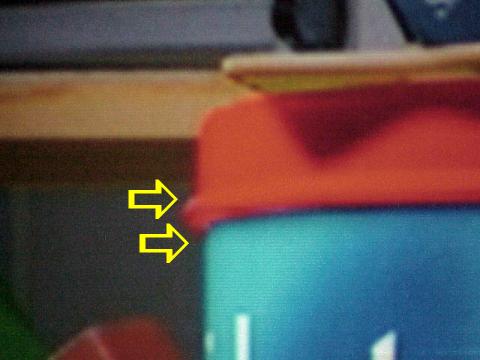
Remember that we use "Toy Story I" as a test for the chroma bug. In chapter 4, Woody is standing at a podium talking to the other toys. The podium is a blue Tinker Toy box with a red lid, as illustrated in the photograph. When the bug is visible, it shows up as horizontal streaks. Notice in the photo how smooth the red and blue regions are where they are next to one another (yellow arrows). This is where the streaks are usually the most intense. The demonstration shows some of the best chroma bug hiding I have yet seen (the Toshiba SD-6200 only has a small amount of the bug, but it is noticeable).
YC delay is minimal if any at all. Here are some shots of the YC test pattern. In the first photo, all three primary colors (red, green, and blue) are shown, and you can see that they all line up pretty much at the 0 reference position (meaning 0 delay).
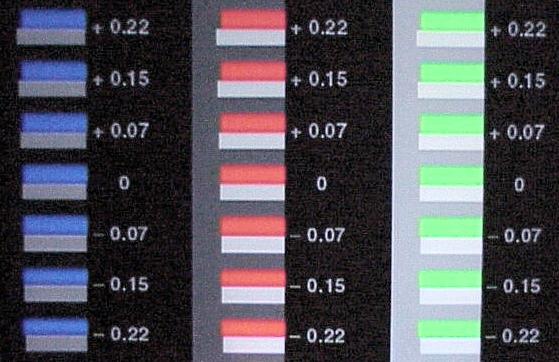
This additional photo illustrates the lack of significant YC delay.
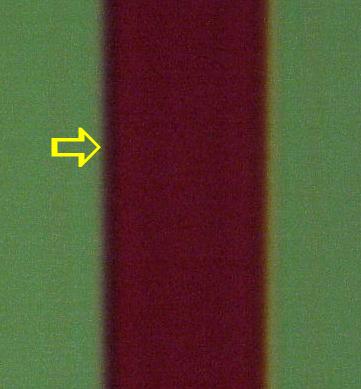
The resolution (bandwidth) of the PFP-11 is specified as 5.5 MHz. However, I was able to distinguish the lines on a 6.75 MHz test pattern, although they were not really crisp (see photo below).
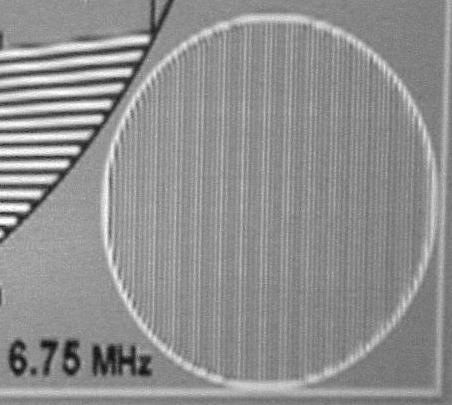
The PFP-11 failed the Snell & Wilcox Zone Plate test. A screen shot of the test is shown below. When the test is running, the layered circles on the right move around in the center of the screen while everything else in the image stays put, and if the test device does its job right, the horizontal lines pointed out by the blue arrow retain their sharpness. For the PFP-11, these lines jittered and became less distinct, which means failing the test. It is a way of finding out whether or not the deinterlacing algorithm is motion adaptive, and if it can isolate moving areas from stationary ones. A failure suggests that resolution can be lost in a stationary picture background when something else is moving in the picture. From these results, it appears the PFP-11 deinterlacer needs some improvement. At present, it uses the Genesis deinterlacing chip.
Motion-adaptive processing is the first step in good video mode deinterlacing. Since there is no "correct" way to deinterlace video, there really is no proper way to evaluate the algorithm. We simply want to make sure it has motion-adaptive capability. We are evaluating a new motion-adaptive test that checks to see if it (the motion-adaptive process) is field-based or pixel-based. Pixel based is better.
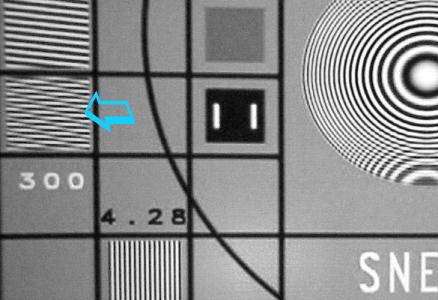
The final result of all of this depends on your DVD player, your display device, and your perception. Although the PFP-11 failed some tests, as all products tend to do, it excelled in others. Frankly, I thought the image to be excellent, and I watched plenty of movies with it in our lab, thank you very much. I will say again how much I appreciated having it work perfectly right out of the box. These days, that is half the bloody battle. After seeing what a scaler can do for various types of displays, I think that it is a toss-up as to how much benefit there is for any particular digital projector (DLP, LCD, DiLA). You just have to try your projector and see. One important point is whether or not the projector will let you bypass its own scaler. Some do, and some don't. My Sony 10HT, for example, does not have a way of bypassing it. But, for plasma displays and CRT projectors, such as the one I used for this review, an outboard scaler, like the PFP-11, makes a huge improvement and is simply a must-have.
Conclusion
It is hard to believe that DVD has been here for several years now. Remember how your jaw dropped when you booted up your first DVD? It is also funny how accustomed we become to good things. Having a beautiful picture is now expected. We dwell on it. We are obsessed by it, compared to those pathetic things we called VHS tapes. Well, it is still getting better. We watch movies at home on 6 foot screens. As a result, the defects of DVD are starting to show up, not only in the discs themselves, but the players and the software that runs them too. Until products like high-performance scalers came along, our jaws were starting to get back in the place where they started out.
Well, it is time for jaw drop again. High-performance digital video processing is here. Not perfect, but nothing is. Well worth having though, assuming you like to see the whole movie and nothing but the movie. The PFP-11 is expensive, but so is the projector. So are our other things in our home theaters. So is everything in life that is valuable to us. Clean air and clean water are not free. Peace and security are not free. And frankly, I am worth it. You will think so too if you see what a product like this can do for your home theater.
- John E. Johnson, Jr. -
![]()
©
Copyright 2002 Secrets of Home Theater & High Fidelity
Return to Table
of Contents for this Issue.

